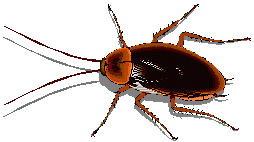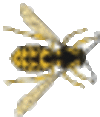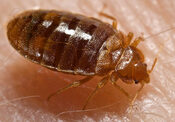WHAT ARE BED BUGS?
Bed bugs are small, reddish-brown, oval-shaped, parasitic insects that subsist off of blood. They can drink blood from birds and mammals, but they like human victims best. Humans offer these voracious insects an all-night buffet and fantastic places to hide when they’re not feasting. These creatures are also world champion hide and seek players, hiding in cracks in walls, in the folds of sheets, in bed frame crevices, luggage and anywhere else that you’re not likely to find them.
BED BUGS CAN COME FROM ALMOST ANYWHERE
You can stay home all day and still manage to get bed bugs if you live in a crowded area with high resident turn-overs, like an apartment complex or dorm. These pests can crawl at similar speeds to ladybugs, and they’re small enough to fit under doors and through cracks. If you don’t spend all day at home, or if you invite friends over, your odds get worse. Friends can bring these bothersome creatures in on themselves and on their pets. If you travel, especially internationally, bedbugs can hitch a ride on you, your clothes or your luggage to infest your home.
HOW TO KNOW WHEN YOU HAVE BED BUGS
The only way to be certain that you have bedbugs is to find them. There are other signs to look for, like new bumps or bug bites that appear overnight, blood smears on your sheets, rashes and skin irritation, bed bug feces in seams of your bedding (small, reddish specks) and moltings, which are light brown in color. In larger groups, these bugs produce a sickly sweet smell similar to overripe raspberries, which can also lead you to suspect an infestation. Still, ultimately, the only way to be positive you have bedbugs is to find living bugs where they’re hiding.
HIRE A PROFESSIONAL
When you realize you have bed bugs, you need to call a specialist. One of the scariest developments regarding these menaces is a recent trend towards resistance to common insecticides. Many home and business owners have tried to go the do it yourself route only to misuse the pesticides they rely on. By doing this, they manage not to kill all of the bugs they were going after, and the remaining bugs start to gain a resistance to the poisons. The only way to ensure that you will not contribute to this problem and that you will actually eradicate your infestation is to hire a professional exterminator. Professional exterminators will use a variety of techniques to make certain that your bed bug problem is completely gone.
STEP 1 – INSPECTION

STEP 2 – EXTERMINATION
Our bed bug control machines produces heat with an output temperature between 210¢ª to 220¢ª degrees. Pests such as bedbugs, dust mites and other allergens along with their eggs are killed on contact at a temperature of 180¢ª degrees. Using heat is an extremely effective and chemical free way to kill these pest along with E. Coli, Salmonella, H1N1 and other bacteria or viruses without leaving any harmful chemical residue behind. The tools and equipment we use allow us to treat all areas where these pests can hide such as bedding, sofas, furniture, pillows, carpet, cracks and crevices that are ideal hiding places for pests.
The clothes / fabric tool with the cotton cover is ideal for treating bedding, furniture, pillows, and carpet areas around bed posts and base boards. Start by installing the supplied cotton cover on the clothes - fabric / smooth surface tool. Apply light consistent pressure and slowly pass it along the surface (1¡± per second) to insure the area being treated has a chance to come to full temperature killing pests and their eggs.

Bed Bugs are becoming more resistant to pesticides; but a safe, effective, and environmentally friendly dry heat process kills the entire life cycle of bed bugs. Homeowners, hotels, and apartment complexes are turning to AlPHA Eco Bed-bug Control to kill all of their bed bug infestation through the specialized use of heat.
Bed bugs can’t withstand heat. At 130 degrees bed bugs die in minutes…

|
Habitat
Bedbugs occur worldwide and are most commonly found nearby sleeping areas.
Bed Bugs are wingless insects, roughly oval in shape, 4-5mm long when fully grown, and are fast runners. They are rust brown in colour and change to a deeper red-brown following a blood meal.
They are blood-sucking insects that require blood for nutrition and development.
Bed Bugs do not live on people nor do they burrow into the skin.
Being a cryptic species, bed bugs shelter in a variety of dark locations, mostly close to where people sleep. These include under mattresses, floorboards, paintings and carpets, behind skirting, in various cracks and crevices of walls, within bed frames and other furniture, and behind loose wallpaper. Bed Bugs tend to stay in close contact with each other and heavy infestations are accompanied by a distinctive sweet sickly smell. Blood spotting on mattresses and nearby furnishings is often a tell-tale sign of infestation.
The cryptic nature of bed bugs and their ability to hide in small spaces means they will be protected from pesticides unless applied thoroughly and correctly.
Bed Bugs are one of the great travellers of the world and are readily transported via luggage, clothing, bedding and furniture. As such, they have a worldwide distribution.
TREATMENT AND RECOMMENDATIONS
Pre-Treatment Recommendations
- DO Remove all linen, clothing and place in plastic bags. Wash in hot water
- DO NOT use the room once Bed Bug infestation has been detected
- DO NOT remove any furniture from the room as all furniture will require treatment
Post Treatment Recommendations
|
- DO Recommend rooms treated are taken out of service for a minimum of 7-10 days
Prevention Tips
- Deny pests food, water and shelter by following good cleaning, sanitation and housekeeping practices.
- Minimise the risk of pests entering the premises by pest proofing the building.
- Improved hygiene and sanitation practices to ensure items such as second-hand furniture, luggage, clothing, etc, are checked prior to putting them into rooms.
-
When do bed bugs usually feed?
If you’ve ever heard the nursery rhyme, “good night, sleep tight, don’t let the bed bugs bite,” you probably know that these critters feed at night. Typically, biting happens about an hour before dawn. However, if hungry, bed bugs will feed any time of the day. The normal feeding frequency for a bed bug is roughly once every five to ten days. However, they can survive for up to a year with no food.
Are bed bugs only a problem for those living in poverty?
No. This is a common misconception. Households of all socioeconomic backgrounds get bed bugs.
Where do bed bugs hide?
Bed bugs do not discriminate. They do not care if you are messy or clean. If there is blood, they are happy. Any place with a high turnover of people is at risk (apartment buildings, schools, hotels, movie theaters, etc.)
In the home, bed bugs are most likely to reside within a few feet of where you sleep. They are typically found in crevices, seams, headboards, and nearby furniture. Although clutter does not cause infestations, it does make them more difficult to get rid of, since there are more places for the bed bugs to hide.
I have bed bugs! What do I do now?
First, take a deep breath and don’t panic. There is a solution.
Next, make a plan.
This is where we come in. We will help you to get rid of bed bugs quickly and without toxic insecticides, and we will help you to create a preventive maintenance plan to prevent future infestations.
How did I come to have bed bugs in the first place?
Most often, bed bugs enter a home or business via luggage, clothing, visitors, used furniture, or a child’s backpack.
How long does it take to get rid of bed bugs?
The answer depends on the type of treatment your select.
Our value or budget packages usually involve the use of insecticide dust, involve thorough preparation, and take up to three treatments before the problem is fully resolved.
Our thermo remediation treatment eliminates bed bugs and their eggs.
In either case, the results will depend on cooperation between you and the pest control professional.
Are heat treatments safe?
When properly performed by trained technicians, structural heating is safe. Pest-Heat™ technology has been applied successfully in tens of thousands of homes and commercial properties . In additional to eliminating bed bugs, structural heat treatments also kill bacteria, allergens, and virus mold, and can even eliminate some long-standing odors.
Why is heat effective?
There are two main reasons why heat works against bed bugs.
First, as a bed bug’s skeleton is 60% water, dehydration due to heat quickly causes it to become paralyzed and die.
Second, bed bugs are naturally attracted to heat because it indicates the presence of a food source. During the heating process, they will come out of their hiding places in search of food. Because of the elevated temperature, they will quickly become too weak to retreat back into their hiding spots, get dehydrated, and die.
To ensure complete penetration of the structure, we use heat probes, eliminating the need to throw out and replace expensive possessions.
I’ve seen ads for a do-it-yourself product. Wouldn’t it be cheaper to get rid of the bed bugs myself?
No.
First of all, these treatments are not effective. According to a recent survey conducted by the , bed bugs ranked as the most difficult pest to eliminate among 76% of pest control professionals, way above termites, ants, or cockroaches. The majority of do-it-yourself sprays and “bombs” contain chemicals to which most bed bugs are already resistant. Further, the sprays typically cause bed bugs to flee the area they are in and spread to another area – possibly all over your home.
Second, do-it-yourself treatments can be damaging to your belongings and hazardous to your health. Irresponsible use of pesticides by homeowners has previously resulted in injury and even death.
Please, always consult a trained professional when dealing with bed bugs.
|
Quick Bed bugs facts:
Bed bugs (also misspelled as bedbugs) are know also as Cimex lectularius L. and belong to the family Cimicidae. A female bed bug can lay 200 - 500 eggs in a lifetime and bed bugs feed on human blood roughly every 7 - 9 days. Read more
Green Pest Management has created a wonderful website with great bed bug information that is sure to help. Don't worry, you're in good company!
Does heat kill bed bugs? How long does it take to kill bed bugs with heat? What is the bed bug heat treatment process?

Bedbugs Hazards: Bedbugs are Dangerous to your Physical and Mental Health
HEALTH HAZARDS
Bed Bugs Health Risks
Bed Bug infestation is a rising epidemic in America, and is quickly becoming a major problem detrimental to public health. With the infestation rates at an all-time high, the Centers for Disease Control and Prevention (CDC) and the U.S. Environmental Protection Agency (EPA) highlight emerging physical and mental public health issues as well as economic consequences associated with the bed bugs (Cimex lectularius) in communities throughout the United States.
Although bed bugs do not transmit infectious disease in the same ways as mosquitos and ticks spread West Nile virus, malaria, or lime disease, there are, however, numerous health risks associated with the bed bugs bites and infestation.
Allergy
Some people may experience mild or severe allergic reaction to the bites of bed bugs, much like some individual’s reaction to bee or hornet stings. Hypersensitivity (anaphylaxis) to the bed bug bites in some people may lead to anaphylactic shock which is extremely dangerous and life threatening. One needs to seek an immediate medical attention in such cases.
Infection
Although bed bugs are not generally known to spread any blood transmitted pathogens, their bites, however, can be very itchy and when scratched one can easily introduce germs into the wound. Since bed bugs usually attack at night, you can scratch yourself spontaneously during your sleep and thus infect the bite site. Also, if a bed bug bites you in a hotel, or just crawls next to you and you in your sleep pop its full of someone else’s blood body, who knows who its prior prey was and what kind of diseases that person had!
Insomnia
Bed bugs can keep you awake all night, thus depriving you night sleep and exhausting you physically and mentally. Some people describe their experience with bed bugs as the worst thing that has ever happened to them in their lives, when they felt completely drained out and worthless.
A person residing within an infested home will often begin to suffer from the effects of insomnia which include but are not limited to anxiety, irritability, inability to focus, depression, loss of appetite, and in some cases psychosis.
Stress and Depression
Constant sleep deprivation combined with itchiness and unsightly reddish bumps and scabs on your skin results in stress and, if left untreated, can lead to depression and immune system weakening.
Latent Illnesses
In turn, weakening your immune system may lead to manifestation of other latent illnesses or illnesses being in a remission.
Social Isolation
If your place is infested with bed bugs, not only you suffer physically and emotionally, you become socially isolated. People stop coming to your place, or send their kids to your place to play with your kids in fear of bringing back to their houses those pesky and disgusting bed bugs. You also stop going to other people places feeling guilty of possibility inadvertently contaminating unsuspecting people houses or apartments.
Keep in mind, that when bed bugs infestation occurs, it’s not going to be a random one time bite attack; they are going to “eat” you methodically, every night. There will be no place to hide, and there is no other treatment except complete extermination.
Bed Bugs & Heat Treatment
Bed bugs are just going ballistic everywhere. It is going to really rock this country.” Bed bugs are found today in hotels, apartments, dorm rooms, delivery vehicles, dry cleaners,including those who offer cleaning services can transfer bedbugs to your premise by carrying their eggs in the equipment they use in jails, hospitals, churches, cruise ships, furniture rental stores and private homes. Rare for a time, bed bug bites are becoming all too common. Because pesticides are losing their effectiveness at treating bed bugs, the search is on for new ways to eliminate infestations. heat kills bed bugs without harming the environment; using heat to kill bed bugs and the eggs they leave behind. And, since Heat® can be effective in a single bed bug treatment, it can be more cost effective than chemical alternatives which can often require replacement of bedding and even mattresses.
WHAT ARE BED BUGS?


Bed bugs are small, oval insects that live in dark spaces close to their food source and feed at night. They range in size from 1/4” to 3/8” long and are mahogany or red-brown in color.
Bed bugs were widespread before World War II in homes, hotels, and boardinghouses, but were greatly reduced with the use of the pesticide DDT. Bed bugs have been making resurgence in recent years due to resistance to chemicals, an increase in international travel, and a developing resistance to pesticides.
Bed bugs commonly reside in the seams of mattresses, in the edges of carpeting, in the bed frame behind baseboards, in window and door casings, picture frames, loosened wallpaper, and other cracks and crevices.
Bed bugs can enter a structure by attaching themselves or their eggs to clothing and bedding and by hiding in luggage. They have often been brought into homes in used furniture and mattresses. In certain cases the pests may be brought in by birds or even bats.
Bed bug bites are not always noticed by their victims. This is often the problem with knowing whether an infestation still exists or if it has been successfully treated. Some people are greatly affected by bed bug bites and may exhibit numerous sores, welts and allergic reactions to the bed bug bite. Others may not exhibit symptoms at all. Although no known cases of the transmission of infectious disease have been reported, bed bugs are known to carry at least 28 different human pathogens. It appears the bed bug may be able to transmit Hepatitis B, as the virus has been found in bed bug droppings. Bacterial infections may also occur if the bite creates an open sore.
DON’T LET THE BED BUGS BITE
KILL BED BUGS WITH HEAT™


Heat® is a superior solution to eliminate bed bug infestations. This non-chemical, non-toxic approach penetrates wall cavities, mattresses and other hard to reach locations to kill bed bugs. By applying heat evenly throughout a structure, we are able to kill bed bugs wherever they are hiding, something many other treatments cannot achieve in a single treatment. Heat® will kill all of the growth stages of the bed bug including the eggs. This is an important fact given that not all current pesticide control methodologies kill bed bug eggs. This means that oftentimes Heat® can eradicate the entire bed bug population in a single treatment.
There is considerable documentation citing the temperature and time correlations necessary to kill bedbugs and their eggs. Several sources (Usinger 1966, Gulmahamad 2002, Quarles 2007) report that adults and nymphs die within 15 minutes at temperatures greater than 113ºF and 60 minutes to kill eggs. Raising room temperatures above the thermal death point and maintaining that temperature for several hours normally eliminates a bed bug infestation.
Heat Eradication Chart
Bed Bugs
Lethal Temperature
Time Duration
| Bed Bug Adults & Nymphs | 113° F / 45° C | 15 Minutes |
| Bed Bug Eggs | 113° F / 45° C | 60 Minutes |
| Bed Bug All Stages | 115° F / 46° C | 7 Minutes |
| | | |
The temperature required to kill bedbugs and their eggs fall well within the temperature ranges achieved by Heat®. The low thermal death point of bedbugs allows Heat® technicians to better adapt the process to the building and its contents while still achieving efficacy. Unlike many pesticides, Heat® will penetrate into all of the cracks and crevices and kill bed bugs where they reside. Our process will force heat into beds, bedding, mattresses, furniture, electronics, wall cavities, etc. leaving no place for bed bugs to hide. This is important because adult bed bugs have been shown to live up to a year on a single blood meal, and may simply go to a small, dark space away from mattresses to live and reproduce.
WHY IS HEAT® BETTER THAN USING CHEMICALS?
Historically, bed bug treatments have relied on the use of chemicals to reduce and control the pest. Recently, pesticides have shown to be ineffective in managing infestations with single bed bug treatment. An informal survey of pest control operators conducted by an entomologist at the University of Massachusetts found that 68% of all bedbug infestations require three or more treatments, 26% require two treatments, and just 6% require one treatment.
Another concern with pesticide use is the growing evidence that bed bugs are developing resistance to current pesticides used in the treatments. This follows the same trend found many years ago when DDT was the accepted treatment. The Integrated Pest Management Association found that by 1956, DDT resistance was so widespread that the control method had to be changed to Malathion.
Results from current research conducted by the University of Kentucky show that bed bug resistance to insecticidal products that have pyrethroids as an active ingredient has become significant. The excessive use of pesticide solutions may result in the bed bug developing greater resistance to current methodologies. Oftentimes this leads to overcompensating by increasing amounts of chemicals. This can be a dangerous practice. Heat® is a simpler control methodology which alters a bed bug’s natural environment, making it lethal to the bed bug.
Pesticides can also pose a threat to the environment. It Works its way through the ecosystem and cause adverse health and reproductive effects to many animals in the food chain.
Finally, some people may be sensitive to chemicals as a result of neurological or other medical disorders. These people may not have the option to use safely chemical solutions as part of their control method. Heat® is a non-chemical process and therefore is the practical solution for people with chemical sensitivities. It is ideal for treating health care facilities, hospitals, and schools where chemicals are not an option.












